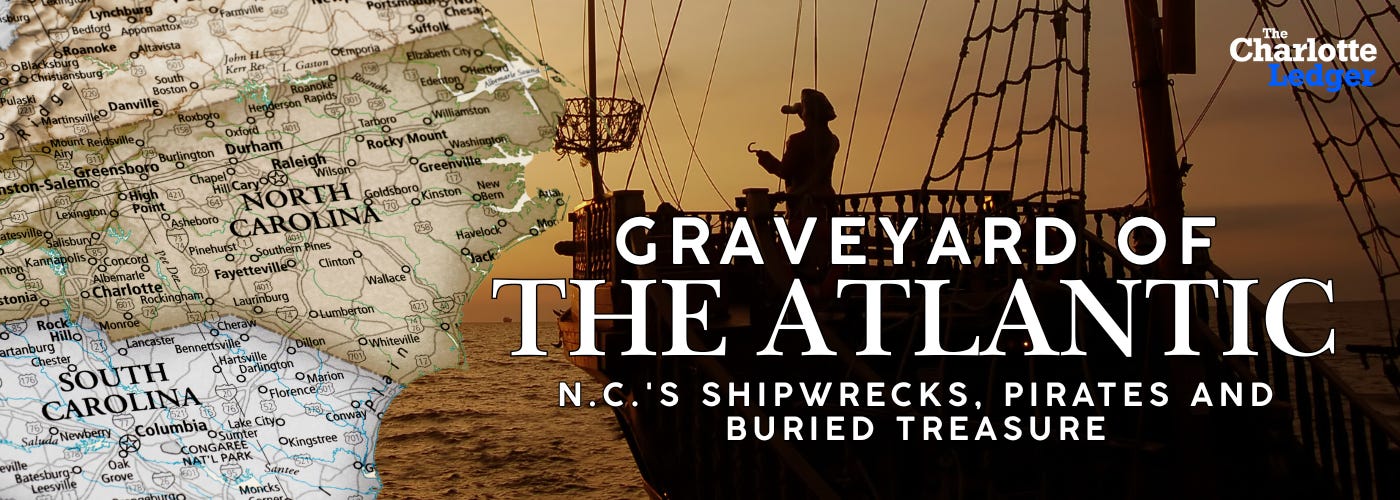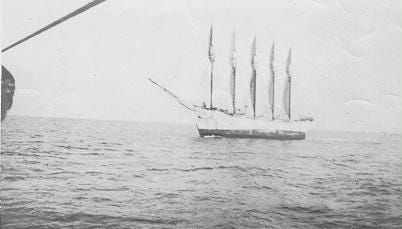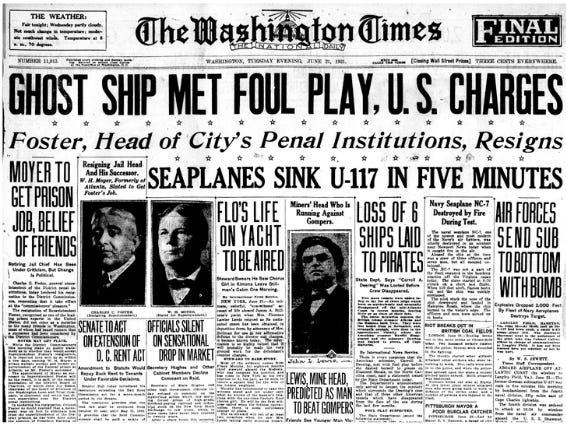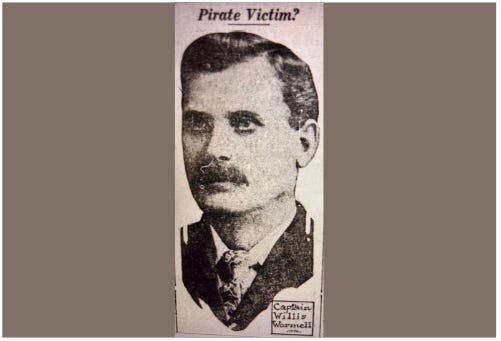The mystery of the 'ghost ship' Deering
Was it mutiny? Pirates? Something else? A hastily abandoned ship off Cape Hatteras leaves behind plenty of questions.
Off the coast of North Carolina lies one of the world’s most treacherous stretches of sea — a place where shifting shoals, sudden storms and centuries of shipwrecks have earned it the name “Graveyard of the Atlantic.” In this Charlotte Ledger series, journalist Mark Washburn explores the region’s lore through wartime sinkings, devastating hurricanes, pirate legends, lost treasure and enduring nautical mysteries.
MONDAY: The Mystery of the Ghost Ship Deering: A schooner runs aground with no crew aboard — only clues, whispers and a six-toed cat remain. (🎥 Watch video)
TUESDAY: North Carolina’s Pirate Legacy: Blackbeard’s legend looms large — but how much of it is true, and where’s the treasure he left behind?
WEDNESDAY: The Tides of War: The quiet beaches of North Carolina once lit up nightly with fire and torpedoes, turning the shoreline into a clandestine battlefield where vessels vanished and history pivoted.
THURSDAY: The Elusive Treasure: Centuries of shipwrecks — but only one treasure fleet ever made it this far north. Is it still out there?
FRIDAY: Tales from the Depths: From daring rescues and doomed voyages to a storm-sunk movie star, these are the shipwreck stories you’ve never heard — but won’t forget.
The full series is available only to Ledger paying members. Join us today:
A schooner runs aground with no crew aboard — only clues, whispers and a six-toed cat remain
By Mark Washburn
Three treacherous maritime regions claim the nickname “Graveyard of the Atlantic.”
There are the windswept seas off Nova Scotia and the volatile waters off Cape Cod. Both swirl with peril. Wrecks underlie both. They are indeed formidable, storied by tragedy.
But as ocean graveyards go, they are but tidy cemeteries. It is off the coast of North Carolina where the Atlantic roars loudest, slaps hardest, unfurls menacing shoals miles from shore where they claw at fragile hulls and tug them mercilessly to the depths.
It is off Cape Fear, Cape Lookout, Cape Hatteras that the surf seethes with caprice. It is off Ocracoke, Whalebone, Kill Devil Hills that two of the biggest heat conveyors on the planet — the chilly Labrador Current of the north and the balmy Gulf Stream of the subtropics — collide like great serpents, occasionally tangling in fierce, turbulent combat.
So mighty is this smashup that it can conjure up, as if by a magician’s snap, its own weather. Here lies the energy to influence cyclones, unleash whirlpools, build or destroy whole islands, sometimes on the same day.
And it is here, the gravest of the Atlantic graveyards, where calamity has long reigned. More than 2,000 shipwrecks lie here, estimates the Graveyard of the Atlantic Museum in Hatteras. A database of the N.C. Underwater Archaeology Branch opts for 5,000.
Pick a number. You might be right, at least until 8:19 p.m., today’s low tide at Hatteras, when the ocean pulls back its skirts to reveal the day’s harvest.
On the inventory of sunken hulls are fishing vessels, cargo ships, German U-boats, a U.S. Navy battleship (victim of friendly fire), sternwheelers, sidewheelers, tankers, pleasure craft, sailboats, stately schooners, pirate sloops, brigantines, blockade runners, a famous Civil War ironclad and a Hollywood replica of the HMS Bounty, which got cameo roles in some “Pirates of the Caribbean” movies.
And, because any proper graveyard requires a spook, one ghost ship. A rather restless one.
Come, this week, one that many of us will spend at beachy destinations. Come aboard, let us prowl the depths and the mysteries of our Graveyard of the Atlantic, and puncture a myth or two on our voyage.
—
Ghost ship: The Carroll Deering
At dawn Jan. 31, 1921, surfman G.P. Brady at the Cape Hatteras Coast Guard station spotted in the stormy mist a five-masted cargo schooner aground on Diamond Shoals. He sounded the alarm. A rescue team was sent.
But the seas were wickedly afroth. Crewmen could safely row no closer than a quarter mile to the stricken ship, stuck firmly in the shoals.
They could see one odd thing — no one appeared to be aboard.
The last known photo of the Carroll A. Deering, taken from Cape Lookout lightship as it passed two days before it went aground. (U.S. National Archives)
It took four days for the sea to calm enough for the wrecking ship Rescue from Norfolk to come alongside the Carroll A. Deering. A boarding party led by the Rescue’s captain, James Carlson, found the ship eerily deserted. Except for a kitten, hungry and scared. And six-toed.
Whoever else had been aboard must have left in a hurry. Sails were still set. Coffee was left on the stove. Food was left on the table. Charts and navigating instruments were gone. So were the ship’s two lifeboats.
Beaches were searched up and down the coast. No bodies, no lifeboats.
Authorities looking into the mystery uncovered more oddities. Capt. Willis Wormell, 66 and well respected, had complained to others in Rio de Janeiro, where he had just unloaded a shipment of coal, that his crew was unruly and his first mate, Charles McLellan, was openly hostile.
When the ship stopped in Barbados on its return leg, a drunken McLellan threatened to kill Wormell, but the mate wasn’t replaced.
On Jan. 29, two days before it went aground, the Deering hailed Lookout Shoals Light Vessel miles off Cape Hatteras at 4:30 p.m. and reported it had lost both anchors, asking that operators send a wireless report to the ship’s owners.
Crewmen aboard the lightship, later shown photographs of Capt. Wormell, said the man on the captain’s deck didn’t look like him. Another oddity: They noted that the Deering’s crew seemed to be milling around in an unprofessional manner.
At 5:45 p.m. on Jan. 30, the Deering was spotted by the southbound SS Lake Elon, whose crew observed it crossing shipping lanes near Hatteras, heading west toward the dangerous waters of Diamond Shoals.
A message in a bottle
A note in a bottle touched off a national investigation into possible piracy off the Atlantic coast.
On April 10, an astonishing discovery was announced by a fisherman at Buxton named Christopher Columbus Gray. He said he’d picked up a peculiar bottle on the beach. Inside was a note:
“Deering captured by oil burning boat … handcuffing crew. Crew hiding all over ship. No chance to make escape. Finder, please notify head Qrtrs of Deering.”
Pirates? Pirates!
A dozen or so ships had vanished in the stormy waters off the North Carolina coast in recent months. There was talk of Bolshevik treachery. U.S. Commerce Secretary Herbert Hoover ordered an investigation.
For months, Lawrence Richey of the Commerce Department worked with the FBI and Treasury agents on the mystery. Finally, on Aug. 20, 1921, he arrived in Buxton and sent word for fisherman Gray to come see him.
Gray assumed it was about his application for work at the Hatteras lighthouse. Are you the one I talk to about the job? Gray asked Richey.
“Before we talk about the job, Mr. Gray,” Richey replied in a conversation — recounted in Bland Simpson’s 2002 book on the Deering, “Ghost Ship of Diamond Shoals” — “I need to clear up a few things with you about the schooner Carroll A. Deering.”
Gray replied that he’d already told investigators all he knew about the message in the bottle.
That uh-oh moment
Richey pulled some official documents from his pocket and handed them to Gray. They were from the top handwriting expert in the U.S. Treasury and his counterpart in the U.S. Navy. Both concluded the mysterious note was, in fact, forged by Gray himself. They'd examined writing samples from Gray’s old Navy service file.
Gray caved. He admitted he’d made the whole thing up to make the crew at Hatteras look irresponsible and boost his own image. Maybe someone would get fired and he’d get a regular-payroll job.
“He had set off an international alarm about pirates,” wrote Simpson, “buoyed the hopes … of crew relatives that their men were still alive somewhere and cost investigators four months of work.”
Gray was never prosecuted — no existing law quite covered his scheme — but his notoriety followed him around Buxton until his death there in February 1952.
What happened on the shoals?
If not piracy, then what explains the mystery of the Deering?
Mutiny? Was the captain killed by the mate or crew? But why would they abandon the ship?
Smuggling? Barbados, last port of call, was awash in cheap rum during Prohibition. But how could they get it ashore in bulk?
Neither the captain, the mate nor the other nine sailors of the Deering ever resurfaced.
Capt. Willis Wormell. (Washington Times)
In the weeks after grounding, waves and shoals began gnawing at the Deering, a sleek, handsome schooner built two years earlier in Bath, Maine. Within a few weeks, it began to come apart.
In a storm, the bow broke away and washed ashore at Ocracoke. It burrowed into the sand, its ribs occasionally emerging between scouring storms like those of a great whale breaching for a gulp of air, then vanishing again.
This ghostly peek-a-boo went on for 34 years. Then, on Sept. 19, 1955, Hurricane Ione took the bones of the Deering to sea again. Deering’s remains resumed their northerly course, coming to rest nine miles away on Cape Hatteras. It lies there to this day.
Not far from its latest resting place is the old lifesaving station Cape Hatteras. This is where the last living soul from the Deering lived out its days — the six-toed ship’s cat. Rescuers in 1921 adopted it as the station mascot.
To this day, six-toed cats bask lazily at Buxton, perhaps descended from a ghost ship’s pet — and perhaps the only one who knew the last secret of the Carroll A. Deering.
Mark Washburn is a retired Charlotte Observer writer and columnist who lives in Davidson. Reach him at mwashburn76@gmail.com.
—
🎥 Watch a 1-minute video adaptation of today’s ‘Graveyard of the Atlantic’ story by TikTok-er Beck Hassen (beckography on TikTok):
Other recent series from The Charlotte Ledger
◼️ Retiring Well: How to make the most of retirement, from managing money to finding purpose, staying connected and embracing change (April 2025)
“Key takeaways from a conversation about aging” (article and podcast)
Need to sign up for this e-newsletter? We offer a free version, as well as paid memberships for full access to all 6 of our local newsletters:
The Charlotte Ledger is a locally owned media company that delivers smart and essential news. We strive for fairness and accuracy and will correct all known errors. The content reflects the independent editorial judgment of The Charlotte Ledger. Any advertising, paid marketing or sponsored content will be clearly labeled.
◼️ About The Ledger • Our Team • Website
◼️ Newsletters • Podcast • Newcomer Guide • A Better You email series
◼️ Subscribe • Sponsor • Events Board • Merch Store • Manage Your Account
◼️ Follow us on Facebook, Instagram, X/Twitter, LinkedIn









I would never trust a six toed cat.